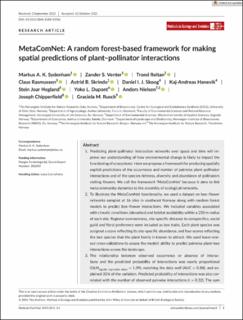MetaComNet: A random forest- based framework for making spatial predictions of plant– pollinator interactions
Sydenham, Markus A. K.; Venter, Zander; Reitan, Trond; Rasmussen, Claus; Skrindo, Astrid Brekke; Skoog, Daniel Ingvar Jeuderan; Hanevik, Kaj-Andreas; Hegland, Stein Joar; Dupont, Yoko L.; Nielsen, Anders; Chipperfield, Joseph; Rusch, Graciela
Peer reviewed, Journal article
Published version
Date
2021Metadata
Show full item recordCollections
Original version
10.1111/2041-210X.13762Abstract
1. Predicting plant–pollinator interaction networks over space and time will improve our understanding of how environmental change is likely to impact the functioning of ecosystems. Here we propose a framework for producing spatially explicit predictions of the occurrence and number of pairwise plant–pollinator interactions and of the species richness, diversity and abundance of pollinators visiting flowers. We call the framework ‘MetaComNet’ because it aims to link metacommunity dynamics to the assembly of ecological networks. 2. To illustrate the MetaComNet functionality, we used a dataset on bee–flower networks sampled at 16 sites in southeast Norway along with random forest models to predict bee–flower interactions. We included variables associated with climatic conditions (elevation) and habitat availability within a 250 m radius of each site. Regional commonness, site-specific distance to conspecifics, social guild and floral preference were included as bee traits. Each plant species was assigned a score reflecting its site-specific abundance, and four scores reflecting the bee species that the plant family is known to attract. We used leave-one-out cross-validations to assess the models' ability to predict pairwise plant–bee interactions across the landscape. 3. The relationship between observed occurrence or absence of interactions and the predicted probability of interactions was nearly proportional (GLMlogistic regression slope = 1.09), matching the data well (AUC = 0.88), and explained 30% of the variation. Predicted probability of interactions was also correlated with the number of observed pairwise interactions (r = 0.32). The sum of predicted probabilities of bee–flower interactions were positively correlated with observed species richness (r = 0.50), diversity (r = 0.48) and abundance (r = 0.42) of wild bees interacting with plant species within sites. 4. Our findings show that the MetaComNet framework can be a useful approach for making spatially explicit predictions and mapping plant–pollinator interactions. Such predictions have the potential to identify areas where the pollination potential for wild plants is particularly high, and where conservation action should be directed to preserve this ecosystem function. interactions, network, plants, pollinators, predict, random forest
